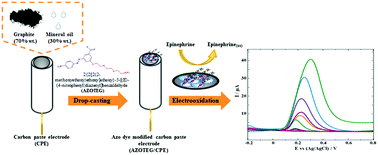A polyoxy group branched diazo dye as an alternative material for the fabrication of an electrochemical epinephrine sensor
Abstract
In the present study, a novel diazo dye with a polyoxy group (2{2[2(2-methoxyethoxy)ethoxy]ethoxy}-5-[(E)-(4-nitrophenyl)diazenyl]benzaldehyde (AZOTEG)) was used as a modifier to fabricate modified electrochemical platforms for epinephrine detection. For this purpose, a carbon paste electrode (CPE), which was the working electrode, was modified with AZOTEG molecules. An increase in epinephrine oxidation peak current with a negative shift in peak potentials demonstrated the electrocatalytic effect of the AZOTEG/CPE compared to the plain CPE. After the observation of this effect, experimental parameters like AZOTEG amount and pH were optimized. Then, the electrochemical mechanism was investigated by obtaining cyclic voltammograms versus scan rates. Under the optimized conditions, the analytical characteristics were examined and as a result, a wide linear range (0.1–75 μM) with a limit of detection and a limit of quantification of 0.013 μM and 0.042 μM (n = 3) were obtained. After the examination of the interference effect of uric acid, the developed sensor was successfully used for epinephrine detection in adrenaline injection samples.



 Please wait while we load your content...
Please wait while we load your content...